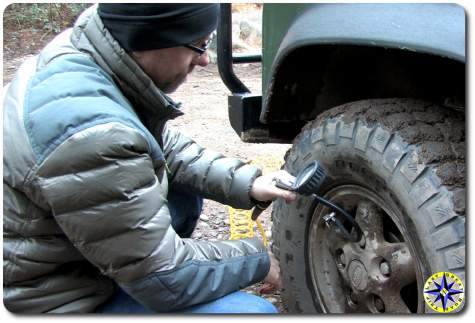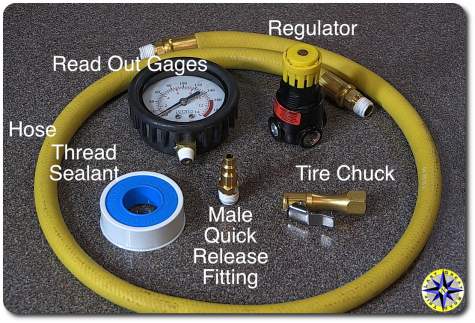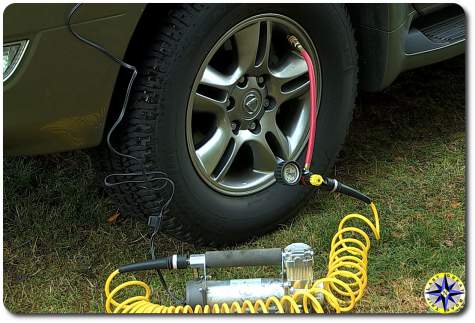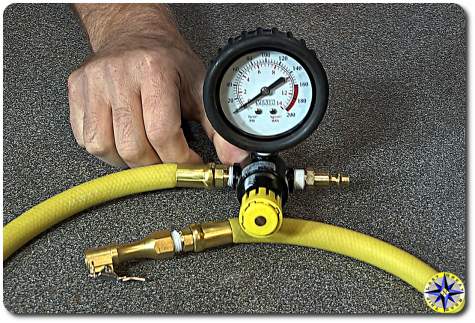 We love the soft, rock gripping ride you get when you air down big E rated, 10 ply off-road tires. Hate is not too strong a word when we have to inflate the tires back up. We often argue about who’s turn it is to sit next to a tire while our little compressor pumps its brains out to re-inflate the rubber up to highway pressure.
We love the soft, rock gripping ride you get when you air down big E rated, 10 ply off-road tires. Hate is not too strong a word when we have to inflate the tires back up. We often argue about who’s turn it is to sit next to a tire while our little compressor pumps its brains out to re-inflate the rubber up to highway pressure.
An air tank will make quick work of re-inflating tires but it doesn’t really work for trips like our Baja overland adventure where we were constantly adjusting our tires’ PSI up and down as we moved between asphalt, desert sand, boulder filled dry riverbeds, muddy swamps and beaches.
We knew there had to be answer… it just took eight years of scouring the Internet and talking to other overlander travelers to figure it out!
We decided to build our own automatic tire infator using an adjustable in-line air regulator??!! What is this tire inflator voodoo witchcraft you ask? Add a common air tool inline regulator that lets you set the desired PSI to a tire inflator, hook it up your air compressor and walk away. The regulator will stop the air flow automatically when the tire’s PSI reaches the preset level.
This project took some experimenting before finding what worked best for us. The key is to start by selecting your regulator, then build your parts list off of the port sizes available on your regulator.
NPT references the national pipe thread taper (aka American standard pipe), refers to the size of a connector and the size of the thread on any connector. The thread size is especially important, because non-standard fittings may not provide a full seal, and will allow air to escape from your hose lines and connectors.
A note on hoses before we get started. The hoses with built-in chucks that we tried seemed to come with flimsy chucks that we managed to break in the field, which is why the recommendation below is to purchase a separate hose and separate locking brass chuck.
What you need (or at lease what worked for us):
- An inline regulator. There are several inline regulators designed for air-tools. We like the Parker 14R118FC Regulator, Relieving Type, 2-125 psi Pressure Range, Gauge, 15 scfm, 1/4″ NPT. You can order the regulator with or without a gauge
- 1/4 in. NPT male brass quick release plug (Foster 3 Series – Brass Plug, 1/4″ Body, 1/4″ NPT – Industrial Interchange, M Style, D Type, I/M, MIL Spec,)
- Goodyear 3′ x 3/8″ Rubber Whip Hose Yellow 250 PSI
- CTA Tools 1930 Straight Lock-On Air Chuck
- Air gauge. Many regulators will come with a gauge. We cannibalized an old manual tire inflator for its gauge that fit the regulators 1/8″ NPT port. Just make sure the gauge’s threads match the regulator’s available port and that it registers above your tire’s max PSI.
To start, attach the brass male quick release plug to the input (or intake) side of the regulator.
To the output side (which is all other ports) of the regulator attach your hose. Attach your brass lock-on air chuck to the end of your whip hose.
Note: to prevent air leaks at the joints, you want to use a little Teflon tape or Permatex 59235 Pst Pipe Sealant on the threads prior to connecting everything.
If you plan to use a gauge, attach it now to an open port on your regulator.
Now following the regulator’s direction, set your regulator to the desired PSI. Depending on the regulator this may take a little trial and error.
With everything assembled, connect your automatic tire inflator to your compressor and test it out on your spare tire to make sure it is stopping at the desired PSI.
That is it!!
Instead of sitting next to each tire for up to 10 minutes, we can now attach our auto-fill tire inflator to our pump, connect the locking chuck to the valve stem, start the compressor and move on to other important things, like checking for trail damage, repacking our recovery kit, changing out of our trail boots, posting a picture to Instagram or just grabbing a soda and sitting in the shade. Gone are the days of sitting next to a tire, up to our ankles in mud while the rain pours down, holding a tire inflator and watching the tire gauge.
 An additional benefit of this regulated automatic tire inflator is that all four tires are at the exact same PSI when it stops. No more back and forth to reset pressure all around.
An additional benefit of this regulated automatic tire inflator is that all four tires are at the exact same PSI when it stops. No more back and forth to reset pressure all around.
Will this little device change our life… probably not… but it will free up time to get repacked and ensure we are ready to go when our last tire is aired back up.
If you don’t want to DIY it… how about the Longacre 50581 Auto-Fill Tire Inflator / Deflator. Longacre Racing does offer an automatic tire inflator… But there is one down side. We found the chuck that attaches to the tire’s valve stem leaves a lot to be desired. The word “cheap crap” comes to mind. Rather than return the inflator (it had been 6 months and a few uses) we went on to Amazon where we picked up a high quality hose for the 1/8″ port they used (Interstate Pneumatics TW100 12 Inch Gray Hose Whip for Inflator) and tire chuck (Coilhose Pneumatics CH15A Open Lock-On Chuck, 1/4-Inch FPT). Easy swap and together they make this a good tire accessory. But it added $18 (+ shipping and taxes) to the overall cost.


Thanks for this Article, I’m Student of Auto Mobile Engineering, & this is a very easy Idea to Make Automatic Tire Inflator that you Shared. Thanks Agin
great article thanks! would this be possible using a digital gauge instead of the analog gauge? the only product i can find is the AUTO1000 Automatic Tyre Inflator. but it’s too damn big to pack into my wheeling truck.
Thanks for the question! A digital gauge will work the same as the analog in this setup. It will provide a relatively close reading of the current PSI in the tire as it fills and then should read at whatever you set the regulator to when the tire is full an the pump shuts off.
The two drawbacks with a digital gauge for me are: 1) that digital readout requires batteries and I tend to forget about checking them when I’m grabbing my gear for an adventure. 2) digital gear does not tend to like getting wet so you need to keep it out in the elements.
I’ve actually built almost the same apparatus, but with 4 hoses so I can inflate and deflate all 4 tires at the same time. The problem with regulators is that they will decrease the flow of air to the tire as the pressure on the tire builds up, how do you overcome that, or do you just let it keep going until it’s done?
Hi. Thank you for this advice, very helpful.
Two questions:
What brand and model of air compressor do you recommend?
What’s better, To install the air compressor into the FJ or have it portable as in the video? Thanks!
I have an VIAIR and used it successfully for 11 years. look for a pump designed for 100% duty cycle to ensure it doesn’t overheat and shutdown when you’re airing up big tires on a hot day. On-board verse portable is a personal choice. I personally like to keep my pump portable.
Great alternative to a critical piece of equipment! Especially at that price! I’d be curious to know how often one of these regulators fail……but it beats the price of company branded auto-inflators by a long shot!
In your article, thank you for this, you mention “air down.” Is the regulator bi-directional. That is, with the chuck on the tire, can you set the desired “down” pressure, and it will bleed off until the down value is reached?
This would be applicable to tire rotation, where front and rear are different pressures.
That would be cool but no this setup only regulates air in…
I have being trying to figure out how to make some thing like this for years just by luck have every thing in my shop to do it I fish the surf with a Class C 4×4 and this will make life a lot easier when we come off the beach to air up thank you Paul Harris
If some one has an older truck with an air cond. that is not working you can tap in to the presser side of it and it will be a good air compressor just open the other side have being use them for the passed 50 years you can put a well pump switch in line and set it to the tire pressor
Paul
just finished making it put 2 out let hoses because I have dual wheels on my class C that I use on the beach took a bit to adjust it got it now going to show it off to the guys that I fish with
Thanks
Paul
Tried with 2 compressors and both failed.
ARB with 4l tank would not even start and king’s Thumper just kept going and would not shut off and if it did it was irregular.
If you put qd fittings on both sides of the regulator you can just flip it and have regulated deflate.
I just built and tested this for my rig and it seems to work well with my Viair 450P compressor. I had to adjust the pressure setting with a little trial and error, but I exepcted that would be the case. However once it is set it seems reproducible, which is the important thing. Thanks for posting this – it will certainly make my life easier when airing up!